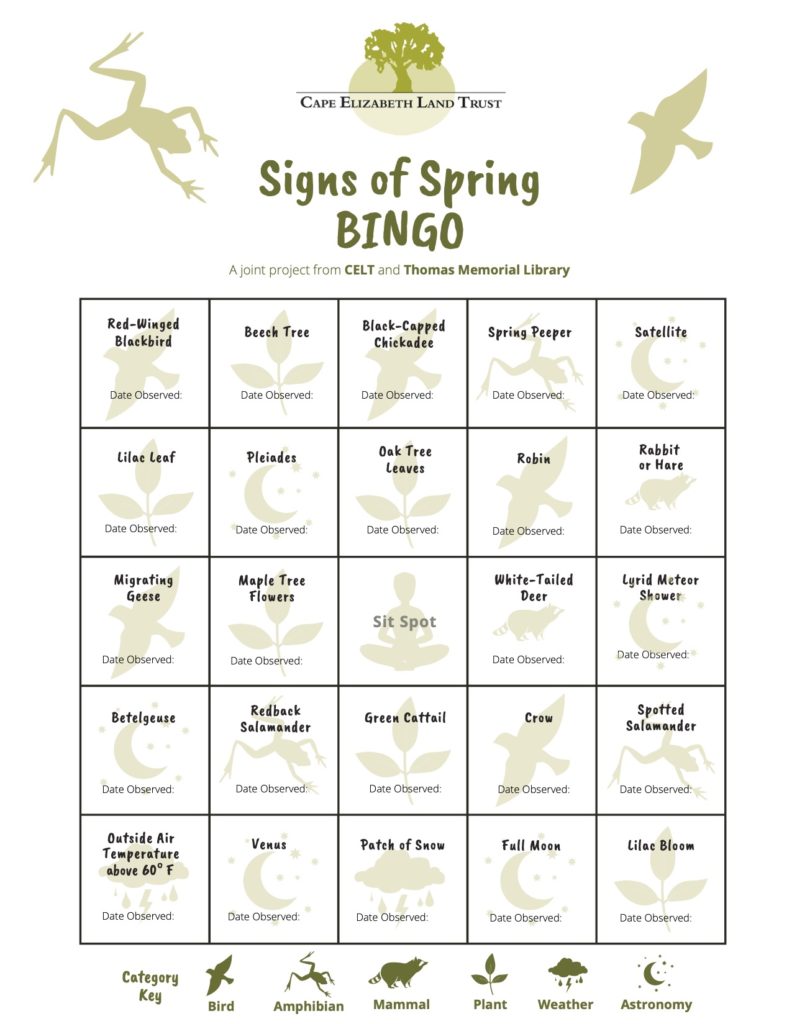Signs of Spring BINGO!
You can also download printable PDF versions of this page:

| Beech Tree: | Beech trees wait all winter to drop their leaves in the spring right before new leaves appear. Hint: Look for pale gold leaves, which will be replaced by soft green growth later in the month. |
| Betelgeuse: | This red giant, a type of star, has dimmed significantly over the past months, generating a buzz of astronomical intrigue. Hint: Look for the constellation Orion, with his three-starred sword and belt, then scan upwards for a red star near his “head.” |
| Black-Capped Chickadee: | Maine’s state bird, the Black-Capped Chickadee is a year-round resident and common bird feeder visitor. Hint: Scan the branches of nearby trees anytime you hear “chicka-dee-dee-dee!” |
| Crow: | While common, crows are among nature’s smartest birds, capable of using tools and recognizing faces. Hint: Listen for a loud “caw!” |
| Full Moon: | The “Pink Moon,” named after the color of blooming spring flowers, will reach full on April 26th. Hint: Weather-permitting, just head outside and look up! |
| Green Cattail: | Cat-tails regenerate each year, sending up new shoots among the dried out stems and leaves from previous years. Hint: Check at the base of leftovers from last season for new, green shoots. |
| Lilac Bloom: | Lilac blooms typically emerge a couple weeks after leaves, providing a second data point for the start of spring. Hint: If you found the leaves already, check back 2-3 weeks later for blossoms. |
| Lilac Leaf: | Lilac leaves and blooms are tracked by scientists accross the country as a proven indicator of the start of spring. Hint: One of the earliest species to put out leaves; check bushes and hedgerows for signs of life. |
| Lyrid Meteor Shower: | Meteor showers occur when the earth, usually on an annual basis, passes through debris left by a comet. Hint: Meteors are easier to see when there is no moon in the sky – keep an eye out in the early morning of April 21-23. |
| Maple Tree Flowers: | Different species of maple will produce different color flowers in spring. Hint: Look for drooping flowers in different colors. |
| Migrating Geese: | Geese are among the easiest birds to recognize as they pass high overhead. Hint: Look up when you hear them, and watch for flocks moving up the coast. |
| Oak Tree Leaves: | This hardwood tree grows yellow flowers and characteristic, multi-lobed leaves in the spring. Hint: Follow the acorns! |
| Outside Air Temperature Above 60° F: | Daytime high temperatures drift slowly upwards as our days get longer and the sun has more time to warm the earth. Hint: Keep an eye out over the course of the day to determine the highest point. |
| Patch of Snow: | In the shadiest spots and rockiest crevices, snow can survive into May, even here in Southern Maine! Hint: If your yard gets a lot of sun, try a shadier park or preserve nearby. |
| Pleiades: | A dense constellation of stars, through which Venus will travel as it peaks this month. Hint: If you found Orion, follow his bow to the right, past V-shaped Taurus, to find this cluster. |
| Rabbit or Hare: | Snowshoe hare shed their coats in spring, returning to brown for better camoflauge. Hint: These are crepuscular, so look at dawn and dusk, when they’re more active. |
| Red-Winged Blackbird: | Red-Winged Blackbirds are one of the first bird species to return in spring. Hint: Listen for a song, and watch for flashes of red as it flies by. Wetlands are your best bet. |
| Redback Salamander: | Maine’s most abundant salamander emerges from underground dormancy in the spring to mate in marshes and vernal pools. Hint: Look under rocks and logs, where moisture stays trapped during the day. |
| Robin: | Robins are another species of bird that returns early in spring. Hint: Keep an eye on lawns and fields, especially on warmer days when insects or worms are more active. |
| Satellite: | Believe it or not, satellites can be easy to spot with the naked eye. Hint: Easiest to spot about an hour after sunset, or an hour before dawn, when they catch the setting/rising sun from their orbits. |
| Sit Spot: | Find a spot to sit and observe the nature around you. What do you notice? Hint: You can return to this same spot throughout the spring (and later) to track changes over time. |
| Spotted Salamander: | These salamanders are less common than Redback, but oftentimes larger and easier to spot. Hint: To maximize your chances, look closer to vernal pools where they might be headed to mate. |
| Spring Peeper: | Perhaps the the most recognizable sound of spring, these frogs flock to freshwater ponds and marshes each spring in hopes of finding a mate. Hint: Easy to detect with your ears, but harder to spot: look for low branches overhanging shallow water. |
| Venus: | This planet returns to the night sky every April, setting on the WNW horizon in the early evening. Hint: The earliest you should look is April 24th, right at twilight and just barely above the horizon. |
| White-Tailed Deer: | A common sight in Southern Maine, keep an eye out for young calves as we move into May. Hint: You’re more likely to spot them near sections of woodland, especially if there are food sources nearby. |
